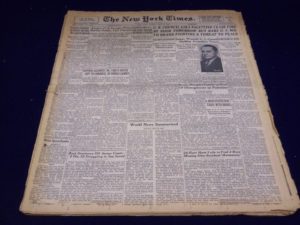Army of Israel Holds Edge in Territory Won in Fighting, Reuters, NY Times, June 2, 1948.
 TEL AVIV, June 1 – With only a few hours to go before the cease-fire deadline in Palestine, Israeli forces were tonight mostly fighting outside the borders of the Jewish state as designed by the United Nations.
TEL AVIV, June 1 – With only a few hours to go before the cease-fire deadline in Palestine, Israeli forces were tonight mostly fighting outside the borders of the Jewish state as designed by the United Nations.
The Palestine battle fronts had crystallized into four fairly definite fronts, with several additional “islands” such as the twenty Jewish settlements in the Negeb, southeast Palestine.
These twenty settlements were still holding out far behind the Egyptian advanced positions at Gaza, Isdud and El Majdal along the coast.
Most complicated was the central front, the Lydda-Ramleh-Lat-run sector, where Israeli forces held the initiative, according to reports here, and the Arab “triangle” of Jenin, Tulkarm and Nablus, further north.
Israeli forces were attacking this triangle by air and land with some success, occupying Arab villages around Jenin and hampering Iraqi troop movements on the road to Tulkarm.
Few changes were reported in the Lydda-Ramleh sector, where Arab irregulars were still resisting Israeli assaults.
In the bitterly contested Latrun sector, in reality part of the battle of Jerusalem, the nine-day battle had undergone “an essential change,” according to Israeli reports here.
“The Jews no longer seek to occupy the village but rather to weaken the Arab Legion for which this battle has become decisive for the prestige and future of King Abdullah’s position in Palestine,” it was stated. The Israeli forces scored their most substantial success against the Syrians and the Lebanese in the north and controlled the whole of western Galilee, a part of the Arab state, according to the partition plan.
There the forces of Israel also held the initiative, according to Israeli sources here, with occasional raids across the Lebanese and Syrian frontiers against troop concentration.
The third front in the northeast, the Jordan Valley south of the Sea of Galilee, was static, with weakening Arab pressure on the Jewish settlements south of Samakh.
The Egyptian drive from the south, along the Arab coastal strip, seemed to have come to a standstill, according to the same Israeli sources here. Israeli irregulars wore active behind the Egyptian lines.
Official Arab reports that Tel Aviv was surrounded and that the Jewish towns of Natanya, north of Tel Aviv, and Naharia, north of Haifa, had been taken were denied here.



